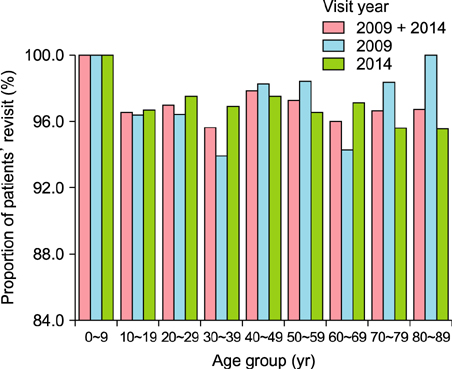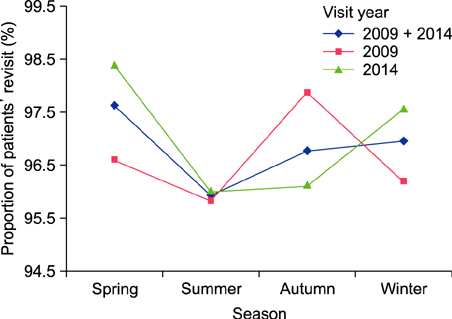Ann Dermatol.
2017 Jun;29(3):307-313. 10.5021/ad.2017.29.3.307.
The Delivery Rates of Pathology Test Results to Patients: A Single-Center Experience in a Secondary Referral Center
- Affiliations
-
- 1Department of Dermatology, SMG-SNU Boramae Medical Center, Seoul, Korea. snuhdm@gmail.com
- KMID: 2378530
- DOI: http://doi.org/10.5021/ad.2017.29.3.307
Abstract
- BACKGROUND
Delivery of pathology reports to the patient is a key step in the biopsy pathway, which is important for patient safety in dermatology. Automated systems for facilitating such medical process began in 2010 in our hospital, sending short message service to scheduled patients.
OBJECTIVE
The purpose of this study was to evaluate the delivery of pathology reports to patients and investigate factors that influence this process and annual trends.
METHODS
We retrospectively reviewed the medical records of all outpatients (n=2,452) who underwent skin biopsy at our department of dermatology in 2009 and 2014. In each year group, we analyzed the proportion of revisiting patients in terms of year, sex, age, season, biopsy method and diagnosis.
RESULTS
In 2009, a smaller proportion of patients (205; 91.5%) who had undergone shave or excisional biopsy than of those who had undergone punch biopsy returned (781; 98.0%; p<0.001). This trend was not significant in 2014. Whereas there was no significant difference of return visit ratio between men and women in 2009, a higher proportion of women (754; 98.0%) than men (633; 95.6%) re-visited after skin biopsy to confirm their diagnosis in 2014 (p=0.008). Three patients with either a malignant tumor or suspected malignant lesion that required complete excision did not return to our clinic.
CONCLUSION
Pathology report delivery rates were fairly satisfactory, regardless of year, age, season, and diagnosis. Sex and biopsy method influenced the return visit ratio. More organized follow-up protocols are required to strengthen patient safety and prevent critical patient drop-out.
MeSH Terms
Figure
Cited by 1 articles
-
Analysis of Judicial Precedents Cases Regarding Skin Cancer from 1997 to 2017 in Republic of Korea
Su Hwan Shin, Won Lee, So Yoon Kim, Gwanghyun Jo, Je-Ho Mun, Soo Ick Cho
Ann Dermatol. 2019;31(3):300-306. doi: 10.5021/ad.2019.31.3.300.
Reference
-
1. Hansen TJ, Lolis M, Goldberg DJ, MacFarlane DF. Patient safety in dermatologic surgery: part I. Safety related to surgical procedures. J Am Acad Dermatol. 2015; 73:1–12. quiz 13-14.2. Kohn LT, Corrigan JM, Donaldson MS. To err is human: building a safer health system. Washington, D.C.: National Academy Press;2000. p. xxi. p. 287.3. Topol P, Porat N, Zelker R, Ingber A, Zlotogorski A, Brezis M. Quality improvement program to assure the delivery of pathology test results: a systemic intervention in a large general hospital. Dermatol Nurs. 2007; 19:253–257.4. Ting TV, Kudalkar D, Nelson S, Cortina S, Pendl J, Budhani S, et al. Usefulness of cellular text messaging for improving adherence among adolescents and young adults with systemic lupus erythematosus. J Rheumatol. 2012; 39:174–179.
Article5. Stewart MA. Effective physician-patient communication and health outcomes: a review. CMAJ. 1995; 152:1423–1433.6. Choudhry A, Hong J, Chong K, Jiang B, Hartman R, Chu E, et al. Patients' preferences for biopsy result notification in an era of electronic messaging methods. JAMA Dermatol. 2015; 151:513–521.
Article7. Al-Shakhli H, Harcourt D, Kenealy J. Psychological distress surrounding diagnosis of malignant and nonmalignant skin lesions at a pigmented lesion clinic. J Plast Reconstr Aesthet Surg. 2006; 59:479–486.
Article8. Boohaker EA, Ward RE, Uman JE, McCarthy BD. Patient notification and follow-up of abnormal test results. A physician survey. Arch Intern Med. 1996; 156:327–331.
Article9. Poon EG, Gandhi TK, Sequist TD, Murff HJ, Karson AS, Bates DW. “I wish I had seen this test result earlier!”: Dissatisfaction with test result management systems in primary care. Arch Intern Med. 2004; 164:2223–2228.10. Ministry of Health and Welfare. Statistical research of trends of the number of daily visiting patients to outpatient clinics in 2009 and 2014; by year and by disease diagnosed [Internet]. Daejeon: Ministry of Health and Welfare;2016. 03. 30. updated 2015. cited 2016 Mar 30. Available from: http://kosis.kr.11. Choi YL, You SA, Lee DY, Lee JH, Yang JM, Lee ES, et al. A survey of awareness, knowledge and behavior regarding skin cancer in Korea. Korean J Dermatol. 2006; 44:405–419.
- Full Text Links
- Actions
-
Cited
- CITED
-
- Close
- Share
- Similar articles
-
- Validity of Referral of High Risk Pregnancy in MCH Center
- Warm autoimmune hemolytic anemia: experience from a single referral center in Mexico City
- The Analysis of Boundary of Laboratory Test Information That is Referred on Internet
- Second Opinion Diagnostic Discrepancy in Surgical Pathology: Asan Medical Center Experience
- Factors Contributing Patients' 'Self Requested Referral' in University Hospital Family Medicine Clinic



